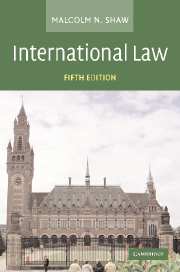Book contents
- Frontmatter
- Contents
- Preface
- Table of cases
- Table of treaties and selected other international instruments
- List of abbreviations
- 1 The nature and development of international law
- 2 International law today
- 3 Sources
- 4 International law and municipal law
- 5 The subjects of international law
- 6 The international protection of human rights
- 7 The regional protection of human rights
- 8 Recognition
- 9 Territory
- 10 Air law and space law
- 11 The law of the sea
- 12 Jurisdiction
- 13 Immunities from jurisdiction
- 14 State responsibility
- 15 International environmental law
- 16 The law of treaties
- 17 State succession
- 18 The settlement of disputes by peaceful means
- 19 Inter-state courts and tribunals
- 20 International law and the use of force by states
- 21 International humanitarian law
- 22 The United Nations
- 23 International institutions
- Some useful international law websites
- Index
- References
23 - International institutions
- Frontmatter
- Contents
- Preface
- Table of cases
- Table of treaties and selected other international instruments
- List of abbreviations
- 1 The nature and development of international law
- 2 International law today
- 3 Sources
- 4 International law and municipal law
- 5 The subjects of international law
- 6 The international protection of human rights
- 7 The regional protection of human rights
- 8 Recognition
- 9 Territory
- 10 Air law and space law
- 11 The law of the sea
- 12 Jurisdiction
- 13 Immunities from jurisdiction
- 14 State responsibility
- 15 International environmental law
- 16 The law of treaties
- 17 State succession
- 18 The settlement of disputes by peaceful means
- 19 Inter-state courts and tribunals
- 20 International law and the use of force by states
- 21 International humanitarian law
- 22 The United Nations
- 23 International institutions
- Some useful international law websites
- Index
- References
Summary
Historical development
The evolution of the modern nation-state and the consequent development of an international order founded upon a growing number of independent and sovereign territorial units inevitably gave rise to questions of international co-operation. Diplomatic representation became more widespread as the system expanded and political and economic relationships multiplied. It soon became apparent, however, that diplomatic contacts in themselves were unable to cope completely with the complexities of the international system and the concept of the international conference evolved as a form of extended diplomacy. Such gatherings dealt with problems that concerned more than two or three states and in many cases resulted in an international treaty or formal peace. The first major instance of this occurred with the Peace of Westphalia in 1648, which ended the thirty-year religious conflict of central Europe and formally established the modern secular nation-state arrangement of European politics.
The French wars of Louis XIV were similarly brought to an end by an international agreement of interested powers, and a century later the Napoleonic wars terminated with the Congress of Vienna in 1815. This latter conference can be taken as a significant turning-point, for it marked the first systematic attempt to regulate international affairs by means of regular international conferences. The Congress system lasted, in various guises, for practically a century and institutionalised not only the balance of power approach to politics, but also a semi-formal international order.
- Type
- Chapter
- Information
- International Law , pp. 1161 - 1215Publisher: Cambridge University PressPrint publication year: 2003

